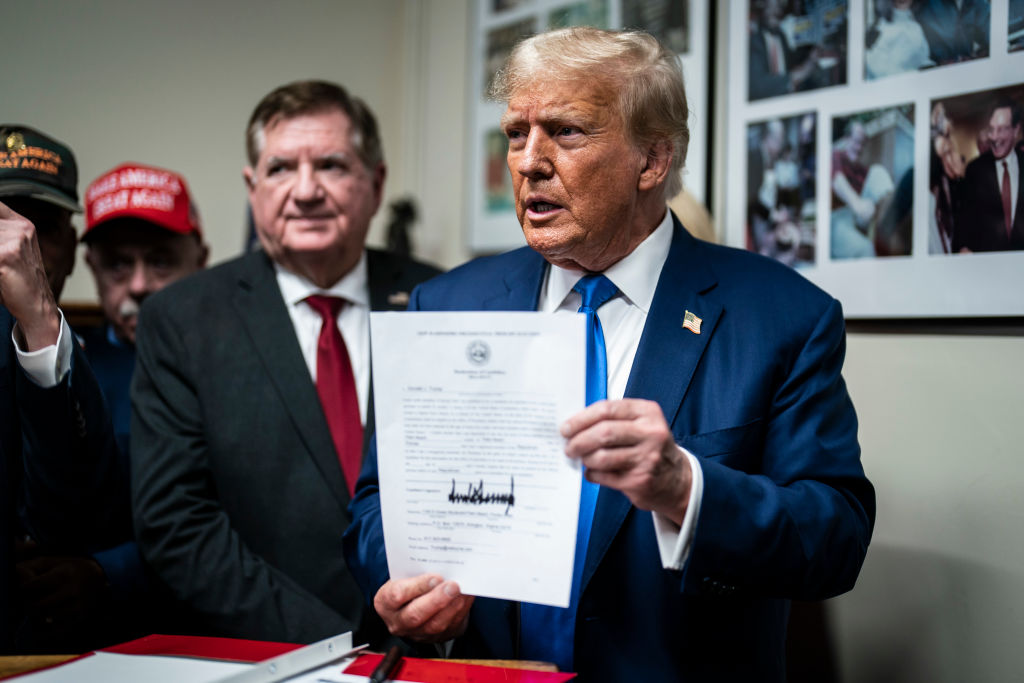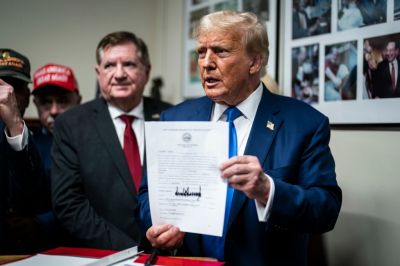The Iowa caucuses kick off the 2024 Republican presidential primary today, and Donald Trump is projected to clean up among a dwindling field of challengers—the first step toward a rematch against Joe Biden in the general election.
The dynamics of this race—which in some ways echo the dynamics of the crowded 2016 Republican primary—have led some to wonder whether Republicans should follow the lead of Democrats in states like Kansas and employ a ranked-choice voting system to select their nominee.
Ranked-choice voting (RCV) is a powerful tool. It empowers voters to offer nuanced opinions, encourages candidates to expand their coalitions beyond their bases and, when used to conduct an instant runoff, ensures winners have broad support. Applied properly, RCV offers promise as a reform to our more common “plurality” elections.
Perhaps its greatest effect could be found in the presidential primaries.
What is ranked-choice voting?
Ranked-choice voting (RCV) is a style of election that allows voters to rank candidates in order of preference, ranking as many or as few as they choose.
With these rankings, states can conduct “instant runoff” elections that require the eventual winner to secure majority support. All of the first-choice votes are tallied, and if one candidate has a majority, game over—he or she wins. But if no one has more than 50 percent of the vote, the last-place candidate is eliminated, and his or her voters’ ballots are re-tabulated using their second-ranked choices. If still no majority winner is found, the process continues by dropping the last-place candidate, reallocating votes, and re-tabulating until one candidate reaches majority support.
RCV is used in states and localities from Alaska to Maine, and although it has some high-profile detractors, the system regularly earns overwhelming praise from voters. However, not all uses of RCV are equally effective. RCV works best when voters view multiple candidates favorably, and when the winner in a plurality election regularly earns less than 50 percent support. Coincidentally, these are the exact dynamics of a presidential primary.
How would RCV impact a presidential primary?
But before wading further down this hypothetical, let’s remember the ground rules that impact the outcomes of primary elections.
First, the GOP regularly awards an outsize share of delegates to whichever candidate wins a plurality of a state’s voters. Unlike Democrats, who grant delegates proportionally in all states, Republicans use a combination of proportional, “winner-take-all,” and hybrid options to commit a state’s delegation. With many candidates in the race, those with the highest vote total in winner-take-all or hybrid elections wins most or all delegates, even if a majority of voters picked someone else. Trump’s 2016 primary victory in South Carolina is instructive: He won all 50 of the state’s delegates despite securing less than a third of the vote in the state.
Second, the primary season truly is a season. Unlike the general election, which centers around one day in November, the primary is a series of elections spread out across the country over months. The results of one state affect voters’ choices in the next, and candidates drop out along the way, leaving fewer meaningful options. The combination of “winner-take-all” delegate allocation and these shifting dynamics means candidates with strong support early in the race can snowball victories into the nomination. Earning a plurality of votes on Super Tuesday, when more than a dozen states hold their primaries, can be enough to catapult a candidate into the general election.
Under these circumstances, RCV can be quite powerful. With voters’ rankings, a state could conduct an instant runoff and award their delegates to the candidate who is truly the most popular in the state rather than one who has a committed base but turns off a majority of voters. This is especially important early in the cycle, when many candidates are on the ballot and winning a state carries more weight.
RCV can also help solve the problem of “wasted votes” on candidates who drop out of the race by reallocating those ballots to still-viable candidates. As absentee and early voting expand across the country, the problem is increasingly acute. In 2016, more than 500,000 votes were cast for Republican candidates who had suspended their campaigns before a given state’s election day. In 2020, more than 2 million such votes were cast for Democratic candidates. It’s easy to imagine that these voters would have appreciated their ballots counting for their favorite remaining candidate.
Additionally, RCV may dampen the urge to engage in “strategic voting.” Under current rules, voters are often encouraged to focus on polling and support candidates who may not be their first choice but whose campaigns appear more viable. As a result, our primary elections often don’t accurately reflect where voters actually stand on the candidates. If a voter likes an unpopular candidate, RCV allows them to demonstrate their support while still ensuring their voice is heard when the race winnows down.
RCV also may help improve our political culture. While early data is mixed, incentive structures created by an instant runoff theoretically encourage candidates to reach beyond their narrow bases of support to gain second-choice votes from other candidates’ supporters. While nationwide RCV wouldn’t herald the end of negative campaigning, it would disincentivize candidates from demonizing their opponents—and perhaps more importantly, their opponents’ supporters.
Would RCV change the outcome of the 2024 Republican primary?
Probably not. Donald Trump, who holds a monumental lead in the polls, would still likely win the Republican nomination no matter the system. But the results would be a lot less certain than they are now.
Heading into the Iowa caucuses, Trump is sitting well north of 50 percent nationally in the RealClearPolitics polling average. With majority support among Republican voters, he would be in line to win an instant runoff in the first round—the rankings would be irrelevant. But the primary election is not a national election, and RCV could have some impact as the race unfolds, starting in Iowa.
Again turning to RealClearPolitics, Trump has just over a majority of support among Republicans in the Hawkeye State. If that polling bears out at the caucuses later today, Trump would win in the first round under an instant runoff. But Iowa is not a “winner-take-all” state; the Iowa GOP allocates its delegates proportionally. This makes RCV potentially useful as a mechanism to set aside also-ran candidates, by requiring a minimum threshold of support for receiving delegates—much like Democrats’ “15 percent rule.” If Republicans had this rule, low-performing candidates—in this hypothetical, Vivek Ramaswamy and Asa Hutchinson—would be eliminated and their votes would be reallocated to Trump, Nikki Haley, and Ron DeSantis, according to their voters’ second-choice preferences.
If some of the more recent polling of the state is correct, DeSantis may struggle to reach a 15 percent minimum threshold as well. Granted, if he is at 13 percent in the first round, it’s likely that some portion of the eliminated candidates’ voters would be reallocated his way, keeping his campaign alive. But if his campaign truly collapsed in the home stretch and he failed to earn 15 percent of the vote, DeSantis’ elimination would result in all delegates being divided between Trump and Haley—likely resulting in a Trump-Haley head-to-head matchup in subsequent states.
Next up is New Hampshire, where an instant runoff using RCV could create quite the drama. Like Iowa, New Hampshire allocates its delegates proportionally. But unlike Iowa, New Hampshire sets a floor at 10 percent support in order to qualify for delegates and allows independent voters to participate. With Chris Christie recently suspending his campaign, only two remaining candidates are polling above 10 percent in the Granite State: Trump (43 percent) and Haley (29 percent).
Using an instant runoff, the votes for Christie (12 percent), DeSantis (7 percent) and Vivek Ramaswamy (5 percent) would be reallocated between Trump and Haley. Assuming the vast majority of Christie’s voters would rank Haley over Trump, the vast majority of Ramaswamy voters would rank Trump over Haley, and most of DeSantis’ voters would rank Trump over Haley, the two candidates would likely split the delegates roughly equally, with a slight advantage to Trump.
At this point, DeSantis and Ramaswamy would be in third and fourth place with no delegates. With no “firewall state” in the near future for either candidate, one could reasonably expect them to drop out. Suddenly, what looks in the real world like an insurmountable lead for Trump has become a tighter, head-to-head contest between the frontrunner and his former ambassador to the United Nations.
Next on the calendar is Nevada, where Haley has opted to run in the state’s primary, which awards no delegates, instead of the state party’s caucuses, which does award delegates. Trump holds a near 60-point lead over the other caucus candidates. Like Iowa and New Hampshire, Nevada allocates its delegates proportionally in the caucuses, and Trump is set to win the vast majority of the delegates there. While RCV would have minimal impact on the outcome of Nevada under current conditions, it is possible that the use of RCV in the caucuses may have encouraged Haley to file. Like Iowa before, Trump’s delegate lead could be dampened by an instant runoff in Nevada, making an investment in campaign operations by Team Haley more worthwhile.
And after Nevada is South Carolina. Trump also appears dominant in the Palmetto State, with more than 50 percent support in recent polls. Unlike Iowa and New Hampshire, the South Carolina GOP allocates its delegates under a winner-take-all system. If Trump maintains his majority position, he would earn all of South Carolina’s delegates in the first round of an instant runoff.
But with a stronger showing in Iowa and New Hampshire with RCV, it’s possible that Haley could chip away at Trump’s lead in her home state, keeping him under 50 percent in the first round. Nonetheless, absent a monumental shift in the race, it’s likely that Trump would still carry South Carolina. While it’s certainly possible for a candidate to jump from second to first place over the course of an instant runoff, Trump’s lead would likely be too big—and his popularity with DeSantis and Ramaswamy voters too high—for Haley to expect to leap-frog him.
By that point, the Republican primary would likely be over. Trump would have won four states in a row, including Haley’s native South Carolina. Republican voters have coalesced around the former president since his various indictments began rolling in, and his polling advantage has generally only increased over the past year. The 2024 cycle doesn’t look like 2016, where a narrow band of Trump-supporting Republicans gave Trump the lead while anti-Trump Republicans split their votes between Ted Cruz, John Kasich, and Marco Rubio. The point of an instant runoff with RCV is to find the most popular candidate, and, in this cycle at least, that’s Trump.
How might RCV impact candidate behavior?
But RCV wouldn’t just impact the mechanics of the 2024 Republican presidential primary—it would likely also impact the actions and rhetoric of candidates, as well as which candidates decide to jump in the race in the first place. After all, the rules of the game affect the way it’s played. Thus, RCV would further complicate the outcome of the 2024 primary by changing candidate behavior and campaign strategy.
Haley and DeSantis, for example, have focused on the other’s shortcomings throughout the primary season. This strategy still has merit under RCV: Both candidates want to be the last one standing against Trump, but they would still need their opponent’s supporters’ second-place votes to win. Any negative campaigning would need to be muted to avoid doing more harm than good.
Beyond the impact to Trump’s top challengers, an RCV system would affect the strategies of the lower-polling candidates as well. Christie, prior to dropping out, was accused of functioning as a “spoiler” candidate for Haley in New Hampshire. RCV would more or less render such criticism obsolete, allowing him to have stayed in the race longer. His continued presence would have given voters yet another way to express opinions on the primary, and RCV would allow them to do so without “throwing away” their votes.
That said, while RCV does create healthier political incentives, it is no panacea. As the dominant leader, Trump would be incentivized to sow confusion about RCV among Republican voters, perhaps encouraging them to rank just one candidate. In so doing, he might reduce the likelihood of a challenger like Haley rising due to second-place votes. With such a large lead, it would be in Trump’s interest to reduce the denominator in subsequent rounds of voting and thus make it easier to win a majority in the runoff. This strategy could backfire—after all, the voters most likely to be influenced by Trump may be the very voters likely to rank him second—but Trump has been known to double-down on strategies that undercut his interests, and it’s possible to imagine him doing so here.
So no, unlike the 2016 primary race—where instant runoffs may have advanced another candidate to the general election—RCV in the 2024 primary would not prevent a Trump primary win. The results would likely be the same. But what it does offer are worthwhile improvements to the presidential primary system. It gives voters a greater say, incentivizes positive campaigning, and prevents a candidate with a passionate but narrow base of support from snowballing early victories in a crowded field.







Please note that we at The Dispatch hold ourselves, our work, and our commenters to a higher standard than other places on the internet. We welcome comments that foster genuine debate or discussion—including comments critical of us or our work—but responses that include ad hominem attacks on fellow Dispatch members or are intended to stoke fear and anger may be moderated.
With your membership, you only have the ability to comment on The Morning Dispatch articles. Consider upgrading to join the conversation everywhere.